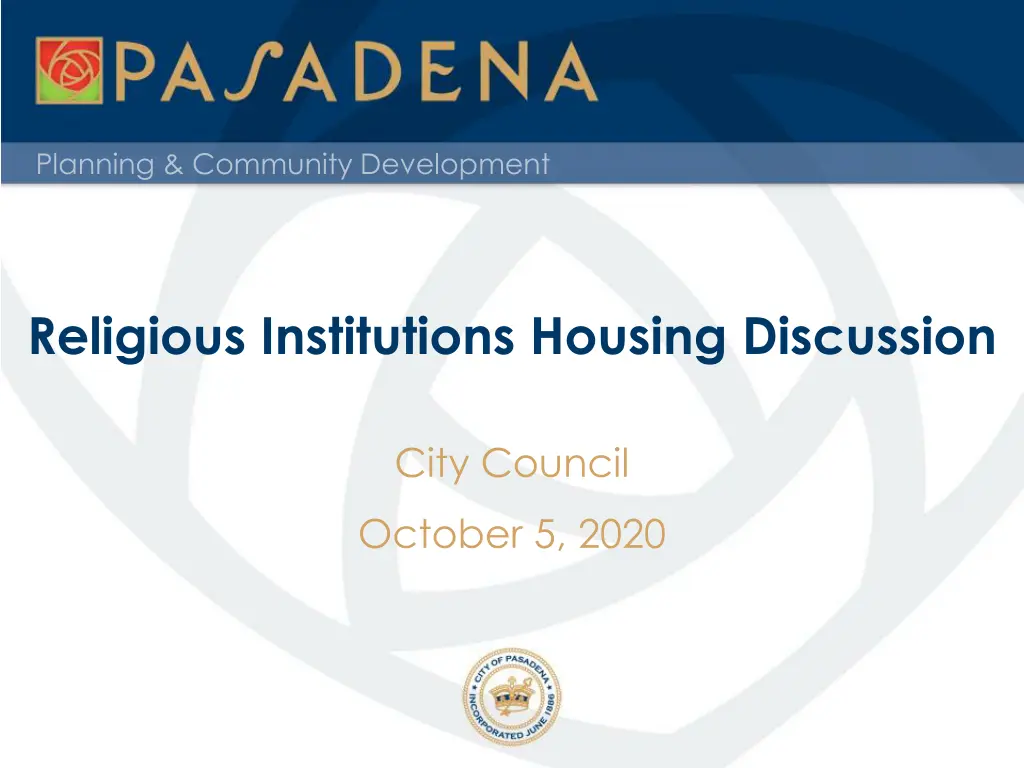
City Council Discussion on Planning & Community Development Issues
"Explore the initiatives and updates regarding temporary homeless shelters and permanent affordable housing on religious properties in the context of planning and community development. Key topics include zoning code amendments, regulations, and examples of transitional housing projects. Get insights on critical issues and provide feedback to the City Council for next steps."
Download Presentation

Please find below an Image/Link to download the presentation.
The content on the website is provided AS IS for your information and personal use only. It may not be sold, licensed, or shared on other websites without obtaining consent from the author. If you encounter any issues during the download, it is possible that the publisher has removed the file from their server.
You are allowed to download the files provided on this website for personal or commercial use, subject to the condition that they are used lawfully. All files are the property of their respective owners.
The content on the website is provided AS IS for your information and personal use only. It may not be sold, licensed, or shared on other websites without obtaining consent from the author.
E N D
Presentation Transcript
Planning & Community Development Religious Institutions Housing Discussion City Council October 5, 2020
Executive Summary Planning & Community Development The City Manager has initiated Text Amendments to address two separate issues: > Temporary homeless shelters associated with Religious Institutions (potential RV use); > Permanent Affordable Housing on Religious Institutional Property; The Planning Commission has conducted study sessions on each item. The City Council has requested that staff provide an update/information to the Council. 2
Purpose of Tonights Meeting Planning & Community Development Provide Background Provide Examples Identify Critical Issues Receive Comments from the City Council Next Steps 3
Background Planning & Community Development Recent efforts by faith-based organizations have prompted discussion of both temporary and permanent housing on religious properties. Several bills considered at the State level; only one was passed (AB 1851). The City Manager has initiated a Zoning Code Amendment to address regulations related to housing on these properties. 4
Background Temporary Housing Planning & Community Development Religious Institutions with Temporary Homeless Shelter exists as a conditionally permitted use in various zones. Specific standards currently exist allowing religious facilities to operate temporary homeless shelters without obtaining a CUP, including: > Within residential, CO, and PS zones, if the religious facility was authorized through a CUP; > No rent or fees may be charged for services; > No more than 10 homeless persons in residential district; > Maximum stay of 60 days; 5
Example Hayward Planning & Community Development > First Presbyterian Church of Hayward > Built 6 mobile tiny homes in parking lot > Temporary transitional housing for 6-12 individuals > Stay up to 18 months 6
Background Permanent Housing Planning & Community Development Religious facilities are currently allowed in a variety of zones, either by-right or conditionally Housing is allowed generally in most zoning districts not permitted generally in CG or IG The allowed density/FAR, setbacks and height are regulated by zoning code and the Church and any proposed housing would need to comply with all standards AB 1851 eliminated the need modify or provide parking for affordable housing on these properties 7
Example San Diego Planning & Community Development > Clairemont Lutheran Church > Seeks to build approximately 12 low-income homes on existing parking lot > City eliminated parking standards based on pew count and reduced overall requirement 8
Example Walnut Creek Planning & Community Development > St. Paul s Episcopal Church > 45 low-income units currently under construction > Project includes community centers with services for homeless and working poor on-site 9
Locations of Religious Institutions Planning & Community Development 10
Discussion Temporary Housing Planning & Community Development Staff seeks input and direction on the following topics: > Appropriate changes for zones that permit, conditionally permit, or prohibit Temporary Homeless Shelters > Increasing maximum stay period (currently 60 days) and other standards > Expanding definition of temporary facilities to include trailers, recreational vehicles (RVs), or other non-permanent structures > Include provisions for utility connections for trailers and RVs > Amending code sections prohibiting the parking of RVs in certain locations on private property and duration of time spent on private property 11
Discussion Permanent Housing Planning & Community Development Staff seeks input and direction on the following topics: > Appropriate zones and site locations for permanent housing on land owned by religious facilities > Development and operating standards Minimum lot sizes, setbacks, height and density requirements Open space requirements Parking requirements Affordability requirements Amenities required Design Review 12
Next Steps Planning & Community Development Council Direction > Proceed with Amendments on open-ended basis > Proceed with Amendments with specific focus on certain housing types or regulatory framework > Do not proceed with Amendments at this time Virtual Community Meeting Prepare Zoning Code Amendment Bring item to Planning Commission for recommendation Return to City Council 13
Planning & Community Development Church Housing Discussion City Council October 5, 2020
CA Govt. Code Section 65583.2 Planning & Community Development Appropriate densities for accommodating lower-income households is defined in Section 65583.2(c)(3)(B) > For jurisdictions in metropolitan counties such as Pasadena, sites must allow at least 30 du/ac. 15
Income Categories Planning & Community Development Current Area Median Income (AMI) for Los Angeles County is $77,300, as published by HCD. Very Low Income = <50% of AMI Low Income = 51-80% of AMI Moderate Income = 81-120% of AMI Above Moderate = >120% of AMI 16






















